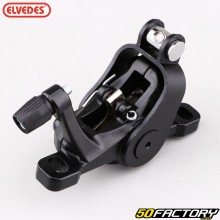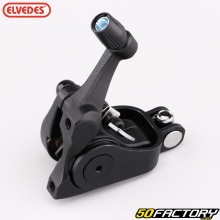 Rear brake caliper
Rear brake caliper
 Rear brake caliper
Rear brake caliper
- STOCK EXHAUSTED21€50
- STOCK EXHAUSTED31€90
- IN STOCK138€10
-
-
-
- IN STOCK69€10
- IN STOCK74€10
Understanding the rear brake caliper for gravel and cyclocross
What is a rear caliper?
A rear brake caliper is a crucial component of a bicycle's braking system. It is responsible for converting the force applied par the cyclist on the brake lever with mechanical or hydraulic pressure that slows or stops the movement of the bicycle. The rear brake caliper, whether disc or rim brake, is essential to ensure effective and safe braking.
Importance of this
For gravel and cyclo bikescross, the rear brake caliper plays a vital role. These bikes are often used in difficult conditions, on varied and uneven terrain. Reliable and powerful braking is therefore essential to ensure the safety of the rider and control of the bike. A good rear brake caliper helps control speed, negotiate steep descents and react quickly to unexpected obstacles.
The different types of stirrups
Disc caliper
Disc brake calipers use metal discs that are attached to the wheel hub. When the rider squeezes the brake lever, pistons push the brake pads against the disc, creating friction that slows or stops the bike. Advantages of disc calipers include greater stopping power, better performance, and better braking performance.ar wet weather, and less rapid rim wear. However, they can be heavier and more expensive than rim calipers.
Skate stirrup
Rim brake calipers, also called rim brakes, use rubber or composite pads that press directly onto the rims to slow the bike. Advantages of rim brake calipers include a lighter, less expensive design and ease of maintenance. However, they can be less effective in the rain and require rims in good condition to function properly.
How to Choose the Right Brake Caliper
Quality criteria to take into account
When choosing a gravel cyclo rear brake calipercross, there are several quality criteria to consider. First, braking power is essential to ensure a quick and efficient response. Then, durability and corrosion resistance are important, especially for cyclists who ride in wet or muddy conditions. Finally, ease of maintenance and adjustment can make a big difference in terms of performance and longevity.
Compatibility
It is crucial to ensure that the brake caliper you choose is compatible with your gravel or cyclo bike.cross. Check the manufacturer's specifications to confirm that the caliper is suitable for your frame and wheels. Also consider the mounting type (post-mount or flat-mount) and the brake rotor dimensions if you opt for disc calipers.
The type of braking
The choice between a disc caliper and a rim caliper depends on your personal preference and riding conditions. If you often ride on muddy or wet terrain,ar wet weather, a disc caliper might be more suitable due to its better performance in these conditions. On the other hand, if you value lightness and simplicity, a pad caliper might be a better choice.
Installation
Installation steps
Installing a rear brake caliper on a gravel or mopedcross may vary depending on the type of brake, but general steps include:
- Remove the rear wheel and old caliper, if applicable.
- Secure the new caliper to the frame using the appropriate mounting screws.
- Align the brake pads with the disc or rim.
- Connect the brake cable or hydraulic hose.
- Adjust cable tension or bleed the hydraulic system to ensure optimum operation.
- Reassemble the rear wheel and test the brakes to make sure everything is working properly.
The necessary tools
To install a gravel cyclo rear brake calipercross, you will need some basic tools:
- Allen keys for mounting screws.
- A cable cutter and cable end caps for cable brakes.
- A bleeding kit for hydraulic brakes.
- Screwdrivers and pliers for fine adjustments.
- A bike stand to hold the bike in place during installation.
Care instructions
Frequency and methods of maintenance
Regular maintenance of your rear brake caliper is essential to ensure optimum performance and extend its life. Here are some tips:
- Clean the calipers and pads regularly to remove dirt and mud.
- Check brake pads for wear and replace if necessary.
- For disc brakes, make sure the rotors are not warped and are properly aligned.
- For rim brakes, check the condition of the rims and replace worn pads.
- Bleed hydraulic brake systems at least once a year.ar an or more frequently if you often ride in the rain or mud.
Signs of wear to look out for
It is important to monitor your rear brake caliper for signs of wear to avoid braking problems:
- Decreased braking power.
- Rubbing or squealing noises when braking.
- Brake fluid leaks for hydraulic systems.
- Uneven or excessive wear of brake pads.
If you notice any of these signs, it's time to check and service your rear brake caliper.













































